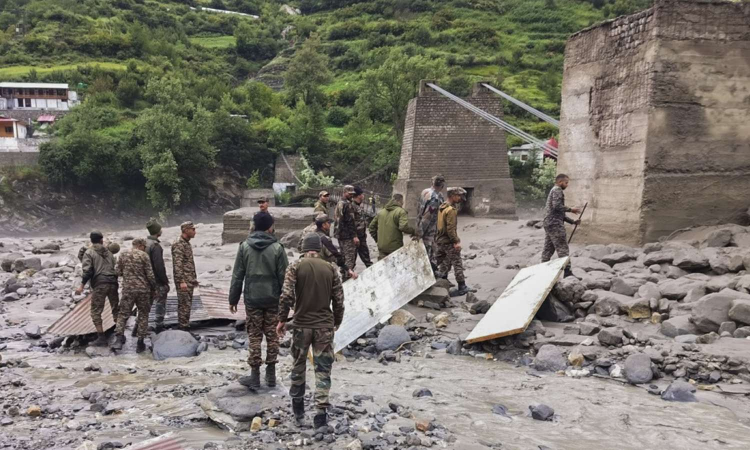Editorial: Eco disasters in the works
The extent and severity of damage were being assessed by the National Remote Sensing Centre (NRSC) / ISRO using very high-resolution satellite images from India’s Cartosat-2S satellites.

Search and rescue operation underway following flash floods triggered by a cloudburst, at Dharali, in Uttarkashi (PTI)
The people of Uttarakhand state, especially those living in the ecologically sensitive zones, have been at the receiving end of recurring floods, mudslides, and landslides. The recent disaster that struck the tourist town Dharali and the nearby Harsil village in Uttarkashi has been captured in harrowing and dramatic video clips showing a large volume of gushing muddy, debris-laden waters destroying everything in its path – homes and other buildings, bridges and roads, and, of course, people. The extent and severity of damage were being assessed by the National Remote Sensing Centre (NRSC) / ISRO using very high-resolution satellite images from India’s Cartosat-2S satellites.
Media reports focused on what caused the disaster – and, contrary to initial speculations, cloudburst was being ruled out based on the amount of rainfall the region had received. But sooner than later, the focus shifted to the big picture and the unending debate of development versus ecological preservation. Pro-environment scientists and activists accept that development is needed. Likewise, pro-development political leaders and bureaucrats aver the importance of the protection of ecosystems. Clearly, there’s a trust deficit between them. One group views the other with deep suspicion and mistrust, often bordering on hostile distrust. Without addressing this seemingly irreconcilable contradiction, it will be difficult to find the much-needed equilibrium between development and the environment.
At the heart of the discourse is not whether development is needed or not, but the scale of development and the model to be pursued. There has been, without doubt, extensive construction activity in the region – be it new buildings to meet the growing demand of the tourism industry, the roads, tunnels, and bridges for improving connectivity, both from tourism and strategic perspectives, and dams and hydroelectric power projects to meet the region’s energy needs. However, the design and models were such that they required felling of trees, which are critical for flood control and mountain stability. Dismissing the concerns of environmental experts, governments increasingly came up with large projects that tend to alter the region’s topography.
The need of the hour is to review the ongoing infrastructure and development projects in the region and make them more compliant with ecological preservation. Secondly, the government should desist from undertaking mammoth projects that could tamper with the Himalayas. Thirdly, multi-disciplinary teams of experts should be involved in the planning and design of projects so that the region’s unique geological features are factored in. Concerted efforts should be made to find the middle ground for a solution-oriented collaboration between ecologists, environmental scientists on the one hand and the government authorities and infrastructure companies on the other. Lastly, mapping of the vulnerable areas using satellite technology needs to be done so that extensive developmental activities, which worsen the situation, are not undertaken.
The country has evolved some effective strategies and mechanisms with regard to rescue and relief operations involving both civil and military personnel working together. Since floods and other disasters cannot be entirely prevented, thanks to natural reasons and also due to climate change, the government needs to evolve flood management strategies specific to the high-altitude region. As the search for missing persons continues and disaster management teams are reportedly using radar technology to locate dead bodies, the importance of early warning systems, which use inputs from high-tech monitoring of weather, water bodies, and glaciers, needs no reiteration.



